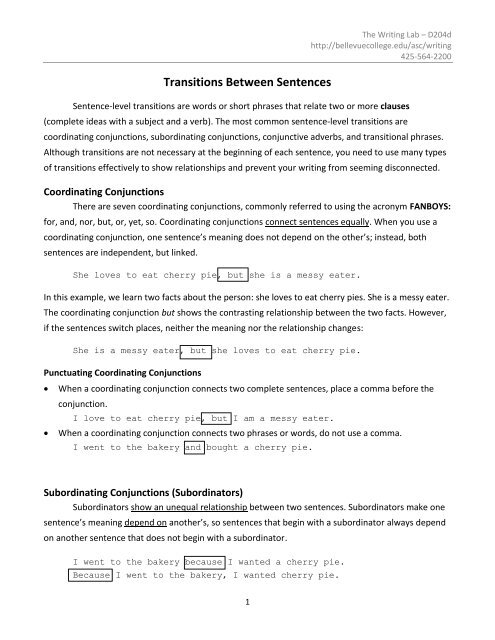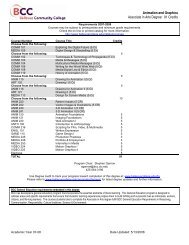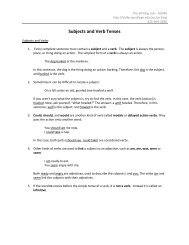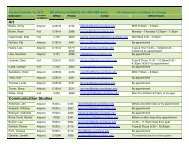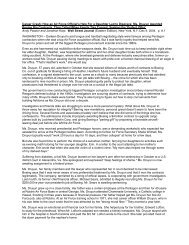Transitions Between Sentences - Bellevue College
Transitions Between Sentences - Bellevue College
Transitions Between Sentences - Bellevue College
Create successful ePaper yourself
Turn your PDF publications into a flip-book with our unique Google optimized e-Paper software.
<strong>Transitions</strong> <strong>Between</strong> <strong>Sentences</strong><br />
The Writing Lab – D204d<br />
http://bellevuecollege.edu/asc/writing<br />
425-564-2200<br />
Sentence-level transitions are words or short phrases that relate two or more clauses<br />
(complete ideas with a subject and a verb). The most common sentence-level transitions are<br />
coordinating conjunctions, subordinating conjunctions, conjunctive adverbs, and transitional phrases.<br />
Although transitions are not necessary at the beginning of each sentence, you need to use many types<br />
of transitions effectively to show relationships and prevent your writing from seeming disconnected.<br />
Coordinating Conjunctions<br />
There are seven coordinating conjunctions, commonly referred to using the acronym FANBOYS:<br />
for, and, nor, but, or, yet, so. Coordinating conjunctions connect sentences equally. When you use a<br />
coordinating conjunction, one sentence’s meaning does not depend on the other’s; instead, both<br />
sentences are independent, but linked.<br />
She loves to eat cherry pie, but she is a messy eater.<br />
In this example, we learn two facts about the person: she loves to eat cherry pies. She is a messy eater.<br />
The coordinating conjunction but shows the contrasting relationship between the two facts. However,<br />
if the sentences switch places, neither the meaning nor the relationship changes:<br />
She is a messy eater, but she loves to eat cherry pie.<br />
Punctuating Coordinating Conjunctions<br />
<br />
<br />
When a coordinating conjunction connects two complete sentences, place a comma before the<br />
conjunction.<br />
I love to eat cherry pie, but I am a messy eater.<br />
When a coordinating conjunction connects two phrases or words, do not use a comma.<br />
I went to the bakery and bought a cherry pie.<br />
Subordinating Conjunctions (Subordinators)<br />
Subordinators show an unequal relationship between two sentences. Subordinators make one<br />
sentence’s meaning depend on another’s, so sentences that begin with a subordinator always depend<br />
on another sentence that does not begin with a subordinator.<br />
I went to the bakery because I wanted a cherry pie.<br />
Because I went to the bakery, I wanted cherry pie.<br />
1
In both of the examples above, the clause that begins with “because” depends on the other sentence.<br />
Unlike coordinating conjunctions, though, when the subordinator changes places in the sentence, the<br />
entire meaning changes. The first sentence shows that the cause “I wanted cherry pie” leads to the<br />
effect “I went to the bakery.” The second sentence says that the cause “I went to the bakery” leads to<br />
the effect “I wanted cherry pie.” See the Appendix for common subordinators and the types of<br />
relationship they show.<br />
Punctuating Subordinating Conjunctions<br />
<br />
<br />
If the subordinator is between the two sentences, do not use a comma.<br />
I went to the bakery because I wanted a cherry pie.<br />
If the subordinator comes in front of the first sentence, place a comma between the two<br />
sentences, NEVER after the subordinator.<br />
Although I got to the bakery early, they were sold out of pies.<br />
Conjunctive Adverbs and Transitional Phrases<br />
Conjunctive adverbs and transitional phrases show the relationship between two sentences<br />
without connecting them. They simply serve to explain how two sentences relate. Strong punctuation<br />
always separates a conjunctive adverb or transitional phrase from both sentences.<br />
I got to the bakery early. Unfortunately, they were sold out of pies.<br />
In the example above, “unfortunately” shows a contrasting relationship between the two sentences.<br />
However, “unfortunately” is separated from the first sentence by a period and from the second by a<br />
comma. This punctuation causes a significant pause for the reader, meaning that the two sentences do<br />
not join; instead, “unfortunately” simply helps the reader move from one idea to the next. See the<br />
Appendix for common conjunctive adverbs and transitional phrases and the types of connection they<br />
show.<br />
Punctuating Transitional Expressions<br />
<br />
<br />
When a conjunctive adverb or transitional phrase joins two clauses, use a semicolon or period<br />
between the two clauses and a comma after the transition expression.<br />
She wanted cherry pie. However, the bakery was sold out.<br />
She wanted cherry pie; on the other hand, I wanted a cookie.<br />
When a transitional expression is in the middle of a clause, put a comma before and after the<br />
transitional expression.<br />
She wanted cherry pie; I, on the other hand, wanted a cookie.<br />
2
Appendix<br />
The following table shows subordinating conjunctions, conjunctive adverbs, and transitional phrases that<br />
indicate certain types of relationships.<br />
Subordinators<br />
Conjunctive Adverbs / Transitional Phrases<br />
To add or show sequence<br />
again also besides equally important<br />
finally first, second further furthermore<br />
in addition in the first last<br />
moreover<br />
place<br />
next still then too<br />
To compare<br />
as as if also similarly likewise in the same way<br />
as though<br />
so… as<br />
just as<br />
To contrast<br />
although despite but at the even so for all that however<br />
same time<br />
even though than in contrast in spite of nevertheless notwithstanding<br />
though on the contrary on the other<br />
hand<br />
To provide examples or intensify<br />
regardless<br />
still<br />
after all an illustration another/ one even<br />
of<br />
example is<br />
for example for instance in fact in particular<br />
indeed it is true of course specifically<br />
that is to illustrate truly<br />
To indicate place<br />
where wherever above adjacent to atop below<br />
beyond close elsewhere farther/ farther on<br />
here in near nearby<br />
north, south, on<br />
on the other<br />
east, west<br />
side<br />
over there to the left/ right<br />
opposite<br />
To indicate time<br />
as as long as after a while afterward at last at length<br />
as soon as after at that time before earlier formerly<br />
before now that immediately in the<br />
in the past lately<br />
meantime<br />
once since later meanwhile now once<br />
until when presently shortly simultaneously so far<br />
whenever while soon subsequently then thereafter<br />
3
To show cause or effect<br />
as because accordingly as a result consequently for this purpose<br />
as long as since hence otherwise then therefore<br />
inasmuch as thereupon thus to this end with this object<br />
To give additional information or support<br />
additionally again also equally important<br />
furthermore in addition to in the first place incidentally<br />
moreover more so next otherwise<br />
too<br />
To indicate chronology or order<br />
after as afterward at last during earlier<br />
before once finally first, second formerly immediately<br />
since until in the<br />
later meanwhile never<br />
meantime<br />
when whence next now once shortly<br />
while subsequently then thereafter<br />
To show logic<br />
because if also as a result because of consequently<br />
since for this reason hence however otherwise<br />
although<br />
if<br />
whereas<br />
even though<br />
though<br />
while<br />
then therefore thus<br />
To repeat, summarize, or conclude<br />
all in all altogether as has been said finally<br />
in brief in closing in conclusion in other words<br />
in particular in short in simpler terms in summary<br />
on the whole that is then therefore<br />
to close<br />
to put it<br />
differently<br />
To concede<br />
To show conditions<br />
as long as if On the<br />
in case<br />
provided that<br />
in order that<br />
so that<br />
inasmuch as<br />
unless<br />
lest<br />
that<br />
condition that<br />
To show purpose<br />
to sum up<br />
to summarize<br />
4


